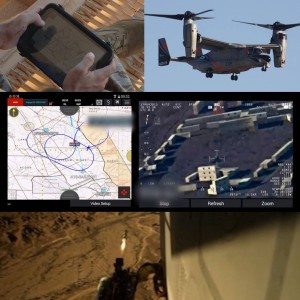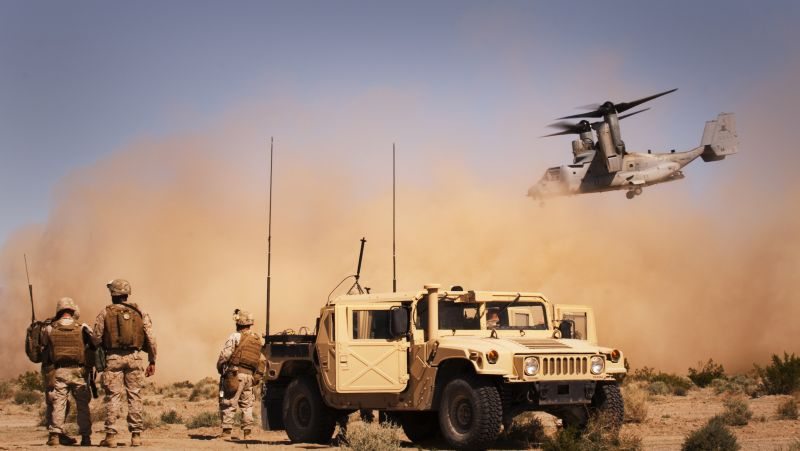Close air support (CAS)-delivery of airborne munitions to support ground forces-is difficult and dangerous because it requires intricate coordination between combat aircrews and dismounted ground forces (for example, joint terminal attack controllers, or JTACs). DARPA’s Persistent Close Air Support (PCAS) program focuses on technologies to enable sharing of real-time situational awareness and weapons systems data through approaches designed to work with almost any aircraft.
PCAS envisions more precise, prompt and easy air-ground coordination for CAS and other missions under stressful operational conditions and seeks to minimize the risk of friendly fire and collateral damage by enabling the use of smaller munitions to hit smaller, multiple or moving targets. This capability is critically important in urban environments.
On March 27, DARPA successfully tested the full PCAS prototype system for the first time as part of TALON REACH, a U.S. Marine Corps infantry/aviation training exercise conducted in the southwest region of the United States in partnership with the Marine Aviation Weapons and Tactics Squadron One and the Marine Infantry Officer Course (IOC).
The demonstration marked the first successful integration of automated, digital, real-time coordination capability into a military aircraft system, including rail-launched munitions, digital data links and advanced software in support of ground forces.
“I am very pleased with the successful PCAS demonstration that we had during TALON REACH,” said Lt. Gen. Jon M. Davis, the Marine Corps’ deputy commandant for aviation. “I have emphasized to my team that we will network every one of our aircraft.”
The success was especially remarkable for how quickly it went from planning to operational testing. “Thanks to the excellent collaboration between DARPA, the Marine Corps and the performers supporting this activity, we were able to conduct a successful demonstration from a standing start in less than 120 days,” said Brad Tousley, director of DARPA’s Tactical Technology Office.

PCAS includes two main components, PCAS-Air and PCAS-Ground. PCAS-Air consists of weapons management, intelligence, surveillance and reconnaissance (ISR), and communications systems located on a modular Smart Launcher Electronics (SLE) device designed to enable plug-and-play hosting of tactical software and mounting of equipment on almost any aircraft.
PCAS-Air communicates with ground forces through PCAS-Ground, a suite of situational awareness and mapping software on commercial Android tablet computers. Two interoperable PCAS-Ground software applications have been developed with government partners: the Naval Air Warfare Center, Weapons Division (NAWC-WD) and the Air Force Research Laboratory’s Rome Labs.
Prior to the full-system demonstration in March, Marines in combat in both Afghanistan and Iraq, with both crisis response Special Purpose Marine Air-Ground Task Forces (SPMAGTFs) and with Marine Expeditionary Units (MEUs), have successfully employed the PCAS-Ground system component, the Marine version of which is called Kinetic Integrated Low-cost SoftWare Integrated Tactical Combat Handheld (KILSWITCH).
KILSWITCH made its debut when DARPA provided more than 750 systems for testing in Afghanistan in early 2013. Since the initial DARPA fielding, Marines have implemented Android tablets in the thousands, and field reports document dramatically improved navigation, situational awareness, fires coordination and communications.
During the full-system demonstration, an IOC JTAC used a PCAS-Ground tablet to identify a target position near an unmanned truck and communicate its position to the PCAS-Air module inside a Marine Corps MV-22 Osprey, a tilt-rotor vertical takeoff and landing (VTOL) aircraft, via a digital link added to the MV-22 as part of the PCAS modifications. PCAS enabled both the JTAC and the aircraft’s weapon systems officer, who also had a PCAS-Ground tablet, to share real-time information, enabling them to quickly confirm the shot and execute the order.
The Osprey fired a non-explosive version of a specially mounted Griffin missile-a tube-launched precision-guided munition-from 4.5 miles (9 km) away to support a simulated downed friendly pilot in the Marine exercise. Guided by a targeting laser, the missile hit exactly where directed and, had it been explosive, would have destroyed the target.
The length of time from initiation by the JTAC to missile impact on target was just over four minutes-even better than PCAS’ goal of six minutes, and more than seven times faster than the half hour or more it can take using current methods that rely on voice directions and paper maps.
“On its first try, the full PCAS prototype system showed we could use a modular, system-of-systems approach to adapt an aircraft to provide close air support, and deliver that capability via real-time coordination with ground forces,” said Dan Patt, DARPA program manager.
“The successful tests point the way to a new model in which the addition of close air support, communications and live ISR support functions to any aircraft would be straightforward, and ground forces would have on-demand access to situational awareness data, modern network-enabled communications and a synchronized digital model of the evolving battlefield.”
Marine ground force leadership recognizes the needs for this capability as well.
“The weaponized and networked MV-22 PCAS demonstration in support of a distributed company-size element was a very important and timely step in ensuring that our MAGTF has the long-endurance, long-range, flexible and precise CAS capabilities required to meet our Commandant’s intent when it comes to distributed operations at the company level, particularly in the urban littoral and in crisis response mission profiles that we’re already executing today,” said Brig. Gen. Julian D. Alford, assistant division commander of the Marine Corps’ 2nd Marine Division.
Another part of the exercise showed the value of the PCAS-Ground system on its own. In a simulated night ground battle between Marines and adversaries, a group of Marines had KILSWITCH tablets but very limited situational awareness of the location of friendly forces and enemy locations.
Another group of Marines, also equipped with KILSWITCH tablets, arrived simultaneously and launched a small unmanned air vehicle (UAV) into the air to provide ISR and network relay capabilities. Within seconds, all the KILSWITCH tablets synced up with the UAV through the Marines’ tactical radios and automatically populated the location of all friendly forces, greatly improving both groups’ ability to coordinate and accomplish their mission.
The PCAS test not only demonstrated new real-time communication capabilities, but also how quickly the system can adapt to different aircraft. Typically, adapting an aircraft to accept a new weapon, mounting rail and targeting system takes at least one year from initial request through live demonstration. DARPA moved from concept to test in less than four months.
The speed was made possible by the PCAS’ SLE and all-digital architecture, which leverages commercial IT products and models such as open interfaces, service-oriented software, element modularity and mobile software applications. Doing this demonstration not on an isolated range, but as part of a major service air-ground training exercise, was made possible by the Marine partners’ aggressive drive to incorporate emerging technologies to enhance warfighting capability.
The test event leveraged efforts from PCAS industry partners, including Raytheon Missile Systems, Bell Helicopter and Rockwell Collins, and included system elements from Kranze Technological Solutions, L-3 Wescam and AeroVironment, Inc.
In addition to the MV-22 demonstration, DARPA is also working on transitioning the system to unmanned platforms with another service partner and performing upcoming flight demonstrations using a U.S. Air Force A-10 Thunderbolt II attack aircraft.
Here is the full statement from Lt. Gen. Davis: “I am very pleased with the successful PCAS demonstration that we had during TALON REACH, where we employed an armed and networked MV-22 with both the Griffin missile and Switchblade UAS in support of our ground combat element, which was operating at a company-minus level almost 200 miles from its [higher headquarters] and any reinforcements.
Given the increasingly distributed nature of the operating environment in which our Marines operate today, I have emphasized to my team that we will network every one of our aircraft, and we’ll also look for ways to arm our aircraft to best fit the scope of their respective missions.
‘Every aircraft a sensor, every aircraft a connector, every aircraft an [electronic warfare] node, and every aircraft a shooter,’ are our goals. DARPA’s PCAS effort is helping us to achieve these goals, and we look forward to continuing this relationship to ensure that our Marines have the absolute best capabilities possible to accomplish any and all missions that the American people need us to accomplish.”










